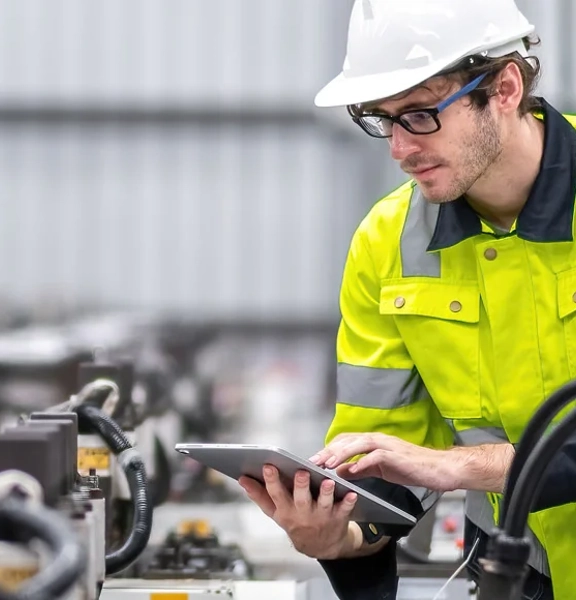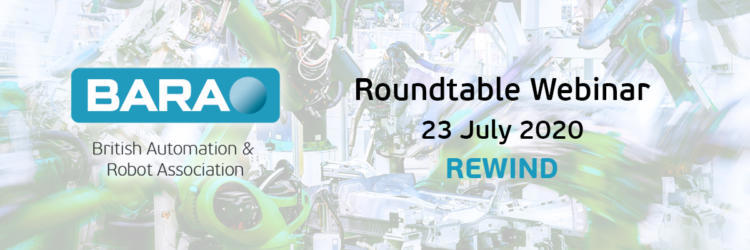Become a member
Take advantage of exclusive member benefits, world class events, networking and specialist support








 Become a member
Become a member 

With the UK food and beverage sector considered to be slow at adopting robot automation when compared to many of its European counterparts, an expert panel ZOOM’d in to discuss the barriers and challenges facing the sector, and what needs to be done to bring about positive change?

You can now watch a highlights video from the BARA Roundtable, which features some of the salient points from the webinar. A media summary is also available below, along with a separate Qs & As.
If you have any additional enquiries regarding this virtual roundtable or about future events, please email marketing@automate-uk.com
Educational and the standard of speakers was excellent.
Joe Maudlin, Ishida Europe.Very insightful discussion by panellists of the problems currently faced in the British automation industry.
Angus Simpson, Scorpion Vision Ltd.Excellent webinar providing a very good cross section of views form a wide range of sectors and organisations with knowledge and expertise in food and drink automation.
Prof. Martin Howarth, National Centre of Excellent for Food Engineering, Sheffield Hallam University.Very informative, relevant speakers and valuable insights.
Steven Lawton, Ferag UK.The selected members for the panel were well balanced and the discussions were thought-provoking.
Bernard Bagley, KUKA Robotics (UK) Ltd.Very interesting insight from some experts in the field at a time when we will be imminently looking at some scale automation projects.
Lee Sanderson, Butlers Farmhouse Cheeses.An informative discussion of criteria / topics relevant to implementation of robotics in the food processing sector.
Adam Gardner, Sentek Solutions Ltd.Web meetings are the future of sharing industry knowledge. They help all sizes of businesses to be involved.
Paul Tilley, Bauromat.Excellent webinar with a wide range of panellists, the BARA done a good presentation to someone looking to move into the Robotics market.
Owain Davies, Mechatronics Industrial Automation & Control Ltd.Very good real world knowledge being shared from the panel.
David Kelly, Omron.Very interesting debate with a lot of information that we as a company can use in the future.
Malcolm Hillary, Apex Dynamics.Interesting views from a wide range of guest speakers really helped to visualise future business avenues.
Grant Copson, Cyan Tec Systems Limited.Extremely interesting webinar, thought provoking.
Mick Williams, CWM Automation.
Machinery Update is the official publication of the PPMA (Processing and Packaging Machinery Association). Launched in 1989, Machinery Update has developed an unrivalled reputation as the prime source of information amongst buyers and specifiers for the processing and packaging industry as a whole.

Martin is currently Director of Engineering and Operations Development at Allied Bakeries. He has worked for over 30 years in food manufacturing in a variety of engineering and operations roles at a several FMCG businesses, including United Biscuits, PepsiCo and Morrisons. He has overseen large automation projects in the snack foods, meat and bakery sectors and has worked with most of the original equipment manufacturers (OEMs) providing automation solutions.

Ian is the Chief Executive Officer for the FDF – the representative voice for companies and trade associations within the food and drink sectors. Before joining FDF in March 2015, Ian spent 14 years with world-leading beverage supplier, Diageo, where he was a member of the executive committee responsible for the company’s reputation. Prior to then, he worked for health and beauty pharmacy, Boots; confectioner, Mars, and even had a successful spell in politics. Ian chairs the Food & Drink Sector Council, the Government’s industry advisory body. He also chairs the Food & Drink Trade Association roundtable. Ian received an honorary knighthood for his political and public service in August 2015.

Mark is an experienced business leader that has been active within the packaging machine automation arena for more than 30 years. He has spent the last 10 years as Managing Director of Schubert in the UK. Schubert is ‘probably’ the most innovative vision guided robotic packaging machine manufacturer in the world. It has been successfully automating production facilities globally for more than 50 years and is now heavily focussed on increasing productivity for its customers throughout the UK.

Bob has over 50 years of practical experience in engineering and is currently the Managing Director of James Mae Industries – a specialist automation company. A large proportion of Bob’s work has been in the field of bespoke automation systems; particularly in the field of Food Manufacturing. He has also been a longstanding member of the BARA Council and has been heavily involved with the introduction of the RIA/BARA Certified Robot Integrators' Scheme in the UK. Bob is a chartered engineer and a Fellow of the Institution of Mechanical Engineers.

Dave has over 30 years’ experience in the banking industry, having joined Lloyds Banking Group in 1988, and has since held various client relationship management and senior leadership roles within the Group. Dave has led the SME & Mid-Corporate Manufacturing sector across the UK since 2014 and continues as Regional Director for the Commercial Banking division across the East of England, from which he leads a team of 70 managers supporting around 7,000 commercial clients. He also sits on a several committees and advisory boards linked to various sector manufacturing & engineering initiatives.

Simon Pearson is Director of the Lincoln Institute of Agri-Food Technology (LIAT) at the University of Lincoln. LIAT is now one of the UK’s leading research groups on agri-food robotics and lead the EPSRC AgriFoRwArds Centre for Doctoral Training, a cohort of 50 PhD’s in robotics supervised jointly between the University of Lincoln, Cambridge and East Anglia. LIAT’s research includes the development of autonomous vehicles, as well-advanced imaging, control and manipulation for the handling of food products. Prior to joining Lincoln, Simon had a leadership role in the agri-food industry for 15 years.

Mike has over 35 years’ experience in robotics and automation gained across a broad range of manufacturing sectors throughout Europe, North America and Asia. He is widely recognised as one of the leading authorities on the application of industrial robot systems in the UK. Mike is the current chairman of BARA (1999-2021) and Chief Automation Officer at the Manufacturing Technology Centre (MTC). He also served as chairman of the International Federation of Robots (IFR) between 2000-2003.
BARA hosted its first virtual roundtable event on 23 July 2020, which brought together several industry professionals and academics from the Food and Drink Federation, BARA Council, Allied Bakeries, University of Lincoln, Schubert UK, James Mae Industries, and Lloyds Banking Group, to discuss whether COVID-19 will drive greater adoption of robot automation in the food sector?
After the initial introduction from the roundtable chair, Gail Hunt (Editor, Machinery Update), followed by the seven panellists, the agenda was split into two segments: the main discussion, and then audience questions. All parties had an opportunity to voice their opinions on a given topic during the 90-minute webinar.
Here is a summary of the key points from the discussion.

There is a consensus that food manufacturers operate at high volume, but very low margins; therefore, the capacity for many businesses to invest at scale is limited. Significant capital investment tends to happen when a business is either doing well, and is well-financed, or the business is struggling to break even, so they do not have a choice. At that stage, there is a propensity to invest disproportionally in new technology to radically improve performance.
While the financial model of a business is fundamental to future investment, disruptive intervention; particularly during COVID-19, is a key consideration for new ways of working, as is the perception of what it entails. Likened to big IT investments, senior managers are often of the view that new robotic systems need to be bespoke and they cannot be implemented across an organisation’s multiple locations.
There are technical barriers to overcome when dealing with certain food-types, such as chilled food; they are not always easy to automate due to their short run times and biological complexities. There is also a lack of trained engineers, which the manufacturing industry at large is working hard to address.
However, adopting the right level of robot automation can give you flexibility and boost efficiencies, but you need to design it right from the outset. There are lots of opportunities to use robots for end of line packing applications; you can remove people from performing mundane, repetitive, and heavy lifting tasks, which are better suited for robots. You can then migrate parts of the labour force onto tasks where their skills and attributes can add value, while being able to maintain social distancing during a crisis.

The bakery industry is certainly one industry that has, among other FMCG sectors, benefited from greater automation to remove heavy manual handling operations. Perhaps the biggest challenge though is not the product itself, but how it is wrapped, which can change frequently with the latest issue being the new tax on plastic packaging (that does not contain at least 30% recycled plastic).
As the manufacturing and retail industries seek to move away from single use plastic, there is renewed interest in 100% paper packaging. Factory automation needs to be able to adapt to avoid machinery becoming obsolete before its time. This move has become stilted through the onset of COVID-19, whereby single use plastic is preferred for reasons of health and safety, and the need to maximise product shelf-life.
Some sub-sectors are now experiencing a much higher take up of robot automation than 10 years ago; particularly in high-volume, high throughput factories, where the return on investment is much shorter. Customers are also looking for more flexibility to administer shorter batches with quick changeovers. This level of flexibility enables factories to upscale or reduce their production times in keeping with scheduled delivery times. In addition, having the option to auto-adjust the size of your product through vision modules on vision-guided robotic picking makes the process even easier. This simply reinforces the need to design the installation correctly with flexibility in mind.

There is plenty of opportunity for regular pick and place for everyday product-types where the format (of the product) is not really going to change. There are lots of prospective investors in robot technology; however, they expect a return on investment within one to two years, which may of course be achievable in some cases, but certainly not all.
COVID-19 has certainly forced many businesses to think more laterally than they did prior to the lockdown. Also, Brexit, and the new Immigration Bill, which effectively closes the door on the freedom of movement people outside of the UK, is causing labour shortages. If you take agriculture and food processing, for example, UK businesses employ in the region of 100,000 migrant workers; positions that will now need to be filled through alternative means after the transition period ends on 31 December 2020.
If you can counter those variances with robots and automation, it could be seen to be an attractive proposition, even to businesses that are financially stretched. It also helps minimise the COVID-19 reproduction rate from which there have been some well-publicised cases in the food supply chain. Moving away from being over-reliant on predominately low paid migrant labour; especially in rural locations, certainly generates some food for thought

There are a lot of UK businesses who still employ people to work cheek by jowl on a production line, which remains a real concern during a global pandemic. This includes sandwich makers and those who work in abattoirs, which can be difficult environments to automate.
While outbreaks of COVID-19 within food factories does little for the industry’s reputation, it is at least helping to highlight some of the issues. When it comes to automation, though, the BARA roundtable panel agreed that the solution is not to go from A to Z and completely “lights outs”. The key to unlocking the future is about embracing robot automation in a considered and phased approach. This largely entails using robots for the everyday, mundane tasks, and humans for tasks that robots are ill-equipped to perform and where humans can add greater value. By adopting this operating model, it can help spread out the workforce, which then starts to address some of the challenges with social distancing.

When it comes to capital funding, the banks have come on a long way since the economic crash in 2008, and not just through tighter regulatory controls. Once considered to be part of the problem, the banks are now hoping to be part of the solution. If you run a business and are experiencing some pushback regarding capital financing or inflexible loan terms from your current provider, look at different providers or brokers. If you are looking to invest in robot automation, your original equipment manufacturer (OEM) supplier may have an additional contact for you to explore potential funding options for new installations.
Whether you are an SME or a larger multinational, consider getting some expert advice: i.e. from robot integrators or the high value manufacturing catapult centres in the UK, such as the Manufacturing Technology Centre (MTC), to gain independent advice and guidance. They can help you plan your project; de-risk it and, if you can present those findings as a part of your business case, assist you to secure the necessary finance.
At things stand, the cost (APR rate) to borrow money has never been so cheap, with interest rates predicted to be lower for longer. Despite this, food and drink manufacturers are plagued by security of contract, with more supermarkets and retailers offering shorter-term contracts than in other sectors, such as automotive and aerospace.
Another consideration is look at acquiring the equipment on a leasehold basis, so you do not start paying for the equipment until it is in your factory earning you money. This removes the need for capital investment.

Schubert has, for example, developed a Light-Line range of equipment. It uses the same Schubert technology; the same robot control systems, but it is a pre-configured machine. Therefore, you can have a pickerline with an integrated flow-wrapper, a cartoner, or case packer; the advantage being the costs are about 30% cheaper than the standard range of equipment from Schubert. Due to its compact configuration, the Light-Line series does come with some nominal scope limitations; however, the lead time on delivery is a lot quicker and the equipment is ready to plug in and switch on.
In addition to the development of digital twins for advanced fast picking robotic systems, another big game-changer is the greater adoption of 3D machine vision technology; in particular, neural networking, which combines artificial intelligence (AI); otherwise known as machine learning or deep learning. If you combine neural networking with new 3D vision cameras, the image processing speed is far superior to your typical classic machine vision, which will have a positive impact on high speed dynamic pick and place systems.
In all cases, it is important to consider the cost of ownership, as well as the cost of purchase; be it financing or capital investment. i.e. How much does it cost to install the equipment, and how much is it going to cost to run and maintain the equipment?

Economic downturn is often the stimulus to innovation and new ways of working. If you cast your mind back to the financial crash of 2008, which was a different economic crisis to COVID-19, it was the catalyst for change. For robot density to increase in the UK, it requires the sponsorship of someone senior in the business to get better acquainted with robot automation, to have a significant stake in the success of the project, from inception through to completion. This can, however, prove challenging given the lifecycle of many senior stakeholders; particularly in the top 30 food businesses in the UK.
Therefore, while robot automation is commonplace in some industry sectors, investing in industrial robot technology is a big cultural shift for many organisations. It can be incredibly appealing and key to business success, but there are some barriers to overcome.
The automotive industry learned a long time ago that automation is best delivered in easy to manage bite-sized chunks, and to automate the things that are easier to automate first, before moving onto the more challenging aspects later. It is not about all or nothing, it is about managing the process as well as expectation.
There is a call for the UK Government to place more emphasis on investing in new robot technology; whether it be access to grant funding or tax concessions. When compared to other nations, the UK needs to make “big bets”, especially at a time when it is willing to the splash the cash to get people back to work and get the economy moving again. Investing in new technology should be part of the Government’s recovery plan.

A good starting point is to talk to your OEMs to ascertain a realistic payback time. Depreciation is an important consideration; however, if you have very good productivity, then you can always write it off over five years. By this time, if the market moves on, your business will not be saddled with a very expensive asset on the books.
It has not been easy to apply financial leasing to robot automation equipment. This is principally due to the equipment’s residual value at the end of the term. When it comes to asset-based finance leasing for robot automation equipment, options are very limited, but more financial providers are aware of the need for it.
It is quite possible that suppliers of industrial robots will eventually provide a cost per usage contract, much in the same way that Rolls Royce charges a unit cost for flight operators per mile. The same can be applied for packaging machinery, where you are not necessarily paying for the machinery, but each time a consumable passes through it.

Safety is paramount, and while elements of the ISO 10218 standard are frustrating due to some areas of inflexibility and practical ergonomics, the international standard will inevitably develop over time to ensure that it is fit for purpose within a practical working environment. This may include relaxing some of the guard heights and safe distance zones.

Environmental factors are not a big driver, it is more about productivity and reducing cost. Flexibility of design is key though to ensure it meets a wide range of uses.
If you would like more information from the event, or explore how robotics and automation could work for your business, please contact BARA at bara@automate-uk.com. A member of the BARA Council or PPMA team will be on hand to respond to your enquiry.

Higher IP (industrial protection) ratings normally come at a higher cost, but that is also subject to the production volumes of the robots. Initially, it may be less costly to provide a protective cover on a standard robot; however, there will be on-going costs to replace jackets. The jackets may not be as effective as the factory supplied higher IP solution, which could reduce the life of the robot and/or increase maintenance costs.

Mixed SKU pallets are used where the volumes of each SKU do not complete a pallet to minimise shipping cost (by maximising the product on the trucks). Agreed this does take time at the factory end but at the supermarket I am not convinced it makes much difference. Therefore, the supermarkets have less incentive to come up with a different approach.

If the brand specifications relate to the selection of specific suppliers for the components of a system (e.g. the robot or PLC) to be supplied to an end user, this is normal practice for many larger companies to ensure their maintenance staff have relevant experience. It also helps to minimise the cost of any spares holdings.

One benefit of robots/automation is the potential to reduce worker density, which given the current challenges regarding COVID-19, may well assist the justification for some projects.

The use of AMRs (autonomous mobile robots) will enhance flexibility, accessibility and reduce maintenance costs. However, the investment required is higher and projects are easier to implement on greenfield sites. Conveyors can provide some benefits, such as floor level changes and cooling buffers. Longer-term, the expectation is AMRs will become much more widespread, but the decision should be made basis on the most appropriate and cost-effective solution for a specific facility or requirement.

I don’t normally look at the OEMs from a flexibility standpoint as they won’t understand our business – normally I try to ensure internal stakeholders (particularly sales and marketing) understand the constraints that we will be building into the manufacturing process e.g. in a packaging automation, the constraints on payload, pack size, packaging material, etc. that the system will impose.

Yes – we (Allied Bakeries) reclaim R&D tax credits annually

Robot accuracy is rarely an issue in food applications, repeatability is more important. However, the tolerances in food production are generally much wider than many other sectors and, therefore, robots can achieve the repeatability required.

There are no significant EU schemes to provide grants to support investment in automation (pre- or post-Brexit). Most EU funding relates to research or innovation and the UK (via universities) has been successful in gaining support via this route. There are adoption support programmes in some countries (e.g. Italy and France), but these are developed and funded by individual countries. The UK has a pilot programme running in the north west of England called Made Smarter.

To date (July 2020), we are not aware that the Groceries Code Adjudicator has considered this issue.

The concept of applying servitisation-type business models has not yet been utilised with automation systems. However, leasing and rental business models are starting to be used. Alternative financing models are likely to become more widely used in the future.

This would be a justification for applying robot-based automation which can provide more flexibility than other forms of automation. Careful consideration should be given to flexibility and future proofing at the design stage by designing in reconfigurability. This may lead to higher cost in the short-term, but lower costs in the long-term.

This can be a significant issue, but always on a case-by-case basis. Ultimately, this challenge needs to be overcome, because the use of outdated, inefficient and unreliable machinery is not a viable approach.

Integration into existing lines and software can be a challenge and it is not the longer-term answer as machinery becomes outdated, inefficient and unreliable.

Robots, typically known as collaborative, must be slower and have lower payloads than industrial (traditional) robots, otherwise they are not safe to work alongside. Industrial robots can be used in “fenceless” situations with appropriate additional equipment. The key issue is the application; picking the appropriate robot, associated equipment and safety systems to perform the required task. This may or may not be a collaborative application.

There are essentially two aspects to this. Firstly, to promote the role/sector and ensure it is seen be interesting and provide good careers. Secondly, to be prepared to provide equivalent packages.

Europe is willing to invest in capital equipment (buy the latest technologies) whereas we have a culture of keeping old machinery running. This is generally true and impacts our willingness to invest in robots. We also have much more flexible labour laws and workforces (e.g. agency staff). This means we can very easily flex our labour pool, whereas in Europe they do not have the same flexibility. Using labour here is not a long-term commitment (unlike capital expenditure), while in Europe it is a long-term commitment. Over the last few years, the UK has attracted significant numbers of eastern European workers which have helps us to meet our labour resource needs.

Schubert is a German company with pedigree in the design and manufacture of Vision-guided Robotic packaging machines spanning 50 years. All of Schubert’s equipment is manufactured in Germany, where we have developed a very well-established skillset in this field. However, the Schubert Group recognises the need for ‘local’ expertise and support. Therefore, in the territories where it makes no logistical sense to provide frontline support from Schubert’s manufacturing centre in Germany, we incorporated Schubert’s 100% owned subsidiaries in the UK, North America, Canada and China. The UK Subsidiary, in operation now for 20 years, has a team of highly experienced ‘local’ technical experts providing excellent customer support.

This could certainly help. Often in other countries (e.g. Germany) the senior management are engineers.

The perception that there are costs and resource requirements outside the reach of SMEs is a factor in some cases, but we need to overcome that perception. There are many SMEs who have successfully implemented robot systems with significant benefits as a result. E.g. Candy Mechanics.

We are making progress and need to keep promoting good case studies and the benefits of automation. There have been many studies demonstrating that robots and automation lead to more and better jobs. Our position is not helped by the confusion relating to Robot Process Automation (RPA) which is and will have an impact on many white-collar roles. The mainstream media do not differentiate between industrial robots in manufacturing and RPA and, therefore, tend to publish negative messages when relating to future employment. However, progress is being made. The House of Commons BEIS Committee conducted a study into “Automation and the Future of Work”, which it published in 2019. The first line of the summary stated: “The problem for the UK labour market and our economy is not that we have too many robots in the workplace, but that we have too few.”

Robots are not necessarily difficult to program. The use of simulation and offline programming tools can make it feasible to use robots for one off type tasks. Flexible systems can be developed to assist in R&D activities. For example: The University of Liverpool has built a robot system undertaking research within its chemical laboratory. https://eurekalert.org/pub_releases/2020-07/uol-lrb070620.php

In the short-term I believe labour reduction is the major issue as labour availability is a growing challenge. Energy (net zero) is a short-term challenge and automation has a role to play in this area. Productivity and cost-reduction will be ever-present requirements. Increased hygiene will also be important with automation, providing the opportunity to implement more hygienic operations.

The major issue in terms of hygiene within high care is normally the workforce. If we can fully automate a high care area it will be much easier to maintain strong hygiene standards.

Innovative solutions often require a champion; someone who is willing to be the first user, but also willing to talk about and promote the solution to other potential users.

Some initiatives of this type exist (e.g. Siemens). There are also leasing, and rental options being developed. However, these financial models are not yet commonplace. It is also worth noting that the cost of capital is very low at present; therefore, providing a good business case exists, which a bank would support, finance should not be a barrier.

All of these factors act as barriers to innovation, but there are others. Risk of failure is a major barrier to implementing innovation, which links to impact/ROI and is the biggest barrier to implementing innovation. However, careful risk management and mitigation can ensure implementing innovation is relatively straightforward.

Harmonised standards are important to ensure that robots are implemented safety. When understood and implied, it should not put people off implementing robots, as they can act as a useful tool. They can be tricky to understand in the first instance, which can deter people; however, there are organisations that can help explain the standards and navigate you through the process.